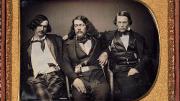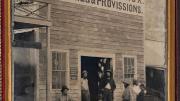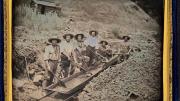The 1848 discovery of gold at Sutter’s Mill launched the dreams and journeys of thousands of people who migrated west to cash in, daguerreotypists among them. “Gold Rush: Daguerreotypes of Early California” (at press time scheduled to be on display at the Peabody Essex Museum through July 12) captures this quintessential era of American history. It was actually the first major American event captured by the early photographic medium, and the real-life images lent credence to rumors of legendary motherlodes. Nearly a hundred images on display reflect untold stories of families and laborers, early mining technology, and the rapid rise of cities, like San Francisco, and smaller “wild West” frontier communities, built around fortune-seeking. “The California Gold Rush was a gamble, and the vast majority were not going to come out rich because of it,” notes Stephanie Tung, associate curator of exhibitions and research. “What we know of the Gold Rush is a mix of both reality and myth.”
American Gold Rush, Peabody Essex Museum
American Gold Rush, Peabody Essex Museum
“Gold Rush: Daguerreotypes of Early California,” at the Peabody Essex Museum

(Click on arrow at right to see additional images)
(1 of 3) Lawman Captain Harry Love and two of his California Rangers (the state’s first law-enforcement agency), circa 1853Photograph courtesy of the Peabody Essex Museum

(2 of 3) Bond & Mollyneaux Groceries and Provisions, Jacksonville, 1852
Photograph courtesy of the Peabody Essex Museum

(3 of 3) Gold miners laboring with a long tom, circa 1850
Photograph courtesy of the Peabody Essex Museum
You might also like
Mount Vernon, Historic Preservation, and American Politics
Anne Neal Petri promotes George Washington and historic literacy.
England’s First Sports Megastar
A collection of illustrations capture a boxer’s triumphant moment.
Creepy Crawlies and Sticky Murder Weapons at Harvard
In the shadows of Singapore’s forests, an ancient predator lies in wait—the velvet worm.
Most popular
Explore More From Current Issue

Mount Vernon, Historic Preservation, and American Politics
Anne Neal Petri promotes George Washington and historic literacy.

A Forgotten Harvard Anthem
Published the year the Titanic sank, “Harvard’s Best” is a quizzical ode to the University.





